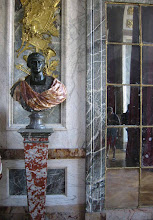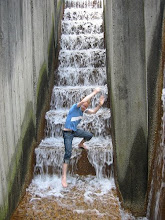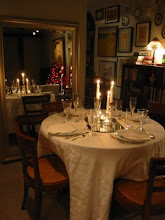I can tell you it was a pilgrimage as the walk up this hill is brutal; bring your climbing gear! But the reward at the end of the slog is one of the masterpieces of the High Renaissance which would inspire architects for centuries to come including Palladio who included it in his Quattro Libri (and don't miss the astonishing views of Rome!).
Once inside the museum (The Spanish Royal Academy) one weaves through cloisters and exhibition spaces to come to the small temple, hence named the Tempietto.
Designed by architect and true Renaissance man Donato Bramante in 1502, the Tempietto was based on earlier Christian churches and ancient Roman temples creating one TINY perfect jewel box of symmetry.
The temple is located in the center of a small cloister which Bramante originally intended to fill with a covered colonnade, which would have obstructed the view of the building. Probably why it was never built although no one knows for sure.
One gets a perfectly framed view of the front face of the Tempietto from the exterior gates (first picture) which faces Rome. Even if the museum is closed you can still at least see the exterior of the Tempietto!
I've been fascinated by this small, perfect structure since college when I first studied the building in both architectural and art history courses. Small buildings give one the opportunity to craft truly perfect buildings. Not only will the entire design be visible in one glance (talk about instant gratification) the budget also tends to be smaller and probably more achievable!
The rear is what one first experiences upon entering the cloister, or courtyard.
The colonnade surrounding the temple is only a few feet wide and built with perfect proportions of elongated Doric columns (my favorite order!) taking your eye up to God.
But lets go inside the main floor.
The interior is just under 15 feet round with the top of the dome being double that amount above you providing perfect proportion.
The ceiling of the dome is decorated with gilt stars on a blue background. The ribs become more slender towards the center to fool your eye into thinking it is higher than it actually is.
As sophisticated as this structure is on every level, it still is an early 16th century building, attested to by the simple wood doors exiting to either side below elaborate shell niches.Contrast this structure with other buildings from the early 16th century and you can see how it was so influential.
Niches on either side of the altar hold statues depicting St Peter.
Don't miss the lovely ancient hand blown glass windows at ground level and stained glass at the mezzanine level above.
The extraordinary marble mosaic floor contains an open grill through which you can see the tomb chamber below.
Around the back where we first entered are exterior stairs which lead you down to the crypt level.
The ornate plaster (or perhaps stonework?) on the ceiling is beautiful and highly elaborate.
This room is kept gated but can be viewed from the base of the stairs. The hole in the enter of the ceiling is the same grate in the floor of the temple above.
If you ever find yourself in Rome I highly encourage a trip up the Juniculum hill to view Bramante's masterpiece the Tempietto or at least the city views. Also be sure to check out the interior of the church which is filled with a treasure trove of Renaissance art.
See plenty of drawings and read more about the Tempietto HERE at Great Buildings Online.
Learn more about Renaissance proportioning at the Tempietto HERE.




















































.jpeg)
























.JPG)







































































